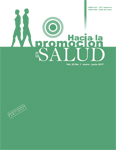Authors
Abstract
Objective: Describe the beliefs and practices of pregnant women older than 35 years who face a pregnancy, hospitalized in a third level institution in Santiago de Cali, Colombia, during the year 2015. Materials and Methods: Ethno nursing (Leininger) was used to explore the emic perspective of pregnant women. The method of James P. Spradley was used for data analysis. Eighteen women, over the age of 35 who were hospitalized in a third level institution, participated. The sample size was defined by data saturation. The information was obtained through in-depth interviews. Results: The participants admitted feelings of frustration and anxiety at the time they realized they were pregnant, which led them to perform selfcare practices favoring both the pregnant women and their unborn child. Those practices helped them to establish relationships with their family support network and in a way less complex overcome the situation they were living. Conclusions: Pregnant women older than 35 years performed care practices influenced by their beliefs, which have been transmitted through oral tradition by their family, friends or peers whom were living the same situation.
References
2. Valls M, Enríquez O, Rodríguez A, López J. Comportamiento del embarazo en mujeres mayores de 40 años. Rev Cubana Obstet Ginecol; 2000; 35(1).
3. García I, Alemán MM. Riesgos del embarazo en la edad avanzada. Rev Cubana Obstet Ginecol. 2013 jun [acceso, enero 06 de 2012]; 39(2): 120-127. Disponible en: http://www.scielo.sld.cu/scielo.php?script=sci_arttext&pid=S0138-600X2013000200007&Ing=es
4. Departamento Administrativo Nacional de Estadística (DANE). Estadísticas vitales nacimientos año 2011. [acceso 21 de agosto de 2015]. Disponible en: http://www.dane.gov.co/index.php/esp/component/content/article/118-demograficas/estadisticas-vitales/2871-nacimientos-2011preliminar.
5. Secretaria de Salud Pública Municipal Santiago de Cali. Reporte de nacimientos vivos de acuerdo con la edad de la madre por comuna. 01 enero-2011 al 31 diciembre-2011. Santiago de Cali, 13 de Junio 2012
6. Rojas-Suárez JA, González M, Monsalve G, Escobar MF, Vasco M. Consenso colombiano para la definición de los criterios de ingreso a unidades de cuidados intensivos en la paciente embarazada críticamente enferma. Rev Colombiana de Obste y Ginecol. 2014; 65 (1): 47-74.
7. Peña W, Palacios J, Oscuvilca E. El primer embarazo en mujeres mayores de 35 años de edad. Rev Per Ginecol Obste. 2011; 57(1): 49-53.
8. Chamy V, Cardemil F, Betancourt P, Ríos M, Leighton L. Riesgo obstétrico y perinatal en mujeres mayores de 35 años. Rev. chil. obstet. ginecol. 2009; 74 (6): 331-338.
9. Lafaurie M, Castañeda KV. Vivencias de gestantes con embarazo de alto riesgo. [en línea] Revista Colombiana de Enfermería. 6 (6): 15-28 [acceso 15 de enero del 2013].
10. Lozano A, Hernández L. Significado de la gestación en mujeres mayores de 35 años. Av Enferm. 2016; 34(1): 8-18. en línea: doi: http://dx.doi.org/10.15446/av.enferm.
11. Boyle J. Estilos de etnografía. En: Morse J., editora. Asuntos críticos en los métodos de investigación cualitativa. 3ª ed. Medellín. Editorial Universidad de Antioquia; 2003. p. 185-211.
12. Leininger M. Ethnography and ethnonursing: Models and modes of qualitative data analysis. In: Leininger M, editor. Qualitative Research methods in nursing. Orlando, Fl: Grune & Stratton; 1985. p. 33-75.
13. Railler M, Marriner T, Ana. Modelos y teorías de enfermería. Séptima edición. Ed. Elsevier. España. 2011.
14. Colombia. Ministerio de Salud. Resolución 8430 del 4 de octubre de 1993. Por la cual se establecen las normas científicas, técnicas y administrativas para la investigación en salud Bogotá: 1993, p. 3. [acceso febrero 2 de 2010]. Disponible en: https://www.minsalud.gov.co/sites/rid/Lists/BibliotecaDigital/RIDE/DE/DIJ/RESOLUCION-8430-DE-1993.PDF.
15. Spradley J, McCurdy D. The cultural experience: Ethnography in Complex Society. 2ª ed. E.U.: Editorial Waveland Press. 2005
16. Castillo E, Vásquez M. El rigor metodológico en la investigación cualitativa. Rev. Colombia Médica. 2003; 34(3):165.
17. Salazar JA. Embarazo de alto riesgo. Colegio Médico de Bolivia. IV Jornada de Educación Médica Continua [en línea] [acceso 26 de noviembre de 2014]. Disponible en: https://es.scribd.com/document/51760811/emb.
18. Waldow V. Cuidado humano: la vulnerabilidad del ser enfermo y su dimensión de trascendencia. Index de Enfermería/Cuarto Trimestre 2014, 23(4): 234 - 238.
19. Leininger M. Culture care. A major contribution to advance transcultural nursing knowledge and practices. J Transcult Nurs 2002; 13: 189-192
20. Noguera N. Significados que las gestantes hospitalizadas le atribuyen a la experiencia de tener preeclampsia. [en línea] Universidad Nacional de Colombia, Facultad de Enfermería. Bogotá, Colombia. 2012 http://www.bdigital.unal.edu.co/9805/1/5539702.2012.pdf [acceso: 6 de febrero de 2015].
21. Gomes A, Kay M, Costa M. Sentimientos, sentidos y significados en pacientes de hospitales públicos en el noreste de Brasil. Rev. Salud Pública. 2009; 11(5): 754-765.


 PDF (Español)
PDF (Español)
 FLIP
FLIP


























